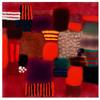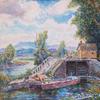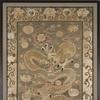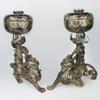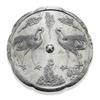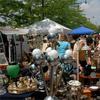Artists of the East End: Past & Present
- NEW YORK, New York
- /
- June 18, 2012
Contact: Betsy Ann Craig (bac@spanierman.com)
Gallery Hours: Monday-Saturday 9:30-5:30
Spanierman Gallery is pleased to announce the opening on June 7, 2012 of Artists of the East End: Past and Present, an exhibition featuring works created from the mid-twentieth century to the present by artists who have lived and worked on Eastern Long Island, drawn by an environment of extreme natural beauty as well as one that has long fostered artistic inspiration and camaraderie.
The exhibition includes works by several artists associated with the New York School. Among them, Perle Fine began spending time on the South Fork in the 1940s and moved to Springs, East Hampton, in 1954. She is represented by four paintings from her Cool Series of 1961-63, exemplifying the tranquil and reflective mood of the color field painting of the era, and one painting from The Accordments, her series in which she used a grid in delicately toned works, compared by a critic to Monet’s water lilies “somehow boxed and gone structural.” Fine was a friend of Mary Abbott, who began extended visits to East Hampton in her youth and has spent summers in Southampton beginning in 1966. Using sweeping, energetic strokes that encompass varying intensities of color, Abbott expresses her personal responses to her subjects as may be seen Red Still Life (1950s), in which she expanded abstract floral forms so that they fill the pictorial space, and in Leaving Home for the Afternoon (2003), which conveys a feeling of exhilaration. In the 1950s, Charlotte Park and her husband, fellow artist James Brooks, established studios on Long Island, close to those of their friends, Jackson Pollock and Lee Krasner. Launching her own version of abstract expressionism, Park achieved radiance with sweeping strokes and a brilliant palette, while maintaining compositional structure, as may be seen in her three paintings in this exhibition. Among the most important women in art world of her day, Betty Parsons was a legendary art dealer who held ground-breaking shows for avant-garde artists including Pollock, Mark Rothko, and Clyfford Still. She was also a dedicated artist in her own right, creating works inspired by the innovative art she showed in her gallery as well as by her own direct responses to nature and the places she traveled, as demonstrated in her two paintings in the exhibition. She began to work on Long Island after receiving an unexpected inheritance in 1959 that enabled her to purchase land on a cliff overlooking the sea in Southold, on the North Fork of the East End.
Other artists who were among the earlier group on the East End include Gertrude and Balcomb Greene, who moved to Montauk Point in 1948, occupying a large house on a high bluff built by Balcomb. Gertrude’s paintings—such as Gothic (1956)—reveal her innovative use of the palette knife to create images of emotional intensity. Balcomb--who outlived his wife for thirty-four years—held an important role in the spread of abstraction in America. An iconoclast and independent-minded thinker, Balcomb had a unique trajectory in his art, proceeding through geometric to biomorphic abstraction and finally to a use of gestural methods to blend the figurative and the abstract. His exploration of the existential and disjointed nature of experience is manifested in works such as Dark Water (1972). David Budd, a native of St. Petersburg, Florida, who moved to New York City in 1954, began to spend summers about the same time in East Hampton. An active part of the abstract expressionist community on the East End, he developed a style influenced by Pollock in which he blended a lyrical sensibility with a powerful gestural handling, created through a liberal use of the palette knife, as may be seen in Port Tampa (1959). Two other artists who spent time on the East End were Neil Williams, represented by Blue Monday (1966), one of his large, hard-edged canvases that were among the first shaped canvases to be created in the minimalist mode, and Syd Solomon, who split his time between Sarasota, Florida, and East Hampton, where he was a friend of Pollock, de Kooning, and Franz Kline. Solomon is known for his experimentation with acrylics, which he used with gestural force, expressing raw and conflicting forces within the natural world, as may be seen in his four paintings in this exhibition.
The exhibition includes the work of several artists who have spent time on the East End in recent years. Dan Christensen first visited and then lived in Springs until his death in 2007. An artist associated with the color field movement, Christensen had a relentless desire to experiment with tools and pictorial space. He is represented in the exhibition by Solar Scope (1969), one of his “plaids,” and Shaanxi (1980), one of his “stains.” The noted critic Clement Greenberg wrote in 1990: “Dan Christensen is one of the painters on whom the course of American art depends.” Of the contemporary artists who continue to find contentment on the East End, Frank Wimberley is among the best known. A resident of New York City and Sag Harbor, he is esteemed by his fellow artists for his masterly abstractions, consisting of unusual manipulations of paint, color, and texture. Dragging and compressing paint, often using a large spatula to allow underpainting to escape through the surface, Wimberley references abstract expressionism’s optical intensity, as in his vivid blue Jonathan (1987) and his lyrical yet energetic Of Course (2011). Other contemporary artists include Carol Hunt, whose dynamic, calligraphic paintings are often inspired by her surroundings in Southampton; Immi Storrs, whose paintings on glass suggest images of the natural world that have been frozen in time; Fulvio Massi, whose mixed media images are expressive of frantic pace of life today; and Susan Vecsey, whose abstract landscapes are reminiscent of the art of Rothko, while reaching beyond the specific to create an iconic and timeless evocation of nature.
Contact:
Betsy CraigSpanierman Modern
212-832-1400
bac@spanierman.com
53 East 58th Street
New York, New York
inquiry@spaniermanmodern.com
212-832-1400
http://www.spaniermanmodern.com
About Spanierman Modern
Specializing in modern and contemporary artists from the mid twentieth century to the present. Please see our artists represented.


